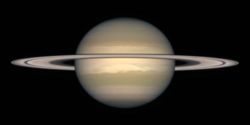Difference between revisions of "Saturn"
m |
(Links, Link fixes/spelling, also not god of time) |
||
| Line 35: | Line 35: | ||
'''Saturn''' is the sixth planet in the [[Solar System]]. Its orbit lies between the orbits of [[Jupiter]] and [[Uranus]]. Saturn is the second largest planet in the Solar System after Jupiter. Saturn is a gas giant, and is famous for its large, complex system of rings. The rings are composed of thousands of rocks made of ices of various chemical compounds, including methane, hexane, and ammonia. | '''Saturn''' is the sixth planet in the [[Solar System]]. Its orbit lies between the orbits of [[Jupiter]] and [[Uranus]]. Saturn is the second largest planet in the Solar System after Jupiter. Saturn is a gas giant, and is famous for its large, complex system of rings. The rings are composed of thousands of rocks made of ices of various chemical compounds, including methane, hexane, and ammonia. | ||
| − | Like the other planets in our solar system, the name Saturn comes from Roman mythology. Saturn is named for the father of [[Jupiter]], the king of the gods in the Roman pantheon. The ancient Greeks called Saturn | + | Like the other planets in our solar system, the name Saturn comes from Roman mythology. Saturn is named for the father of [[Jupiter (god)|Jupiter]], the king of the gods in the Roman pantheon. The ancient Greeks called Saturn [[Cronus]]. |
Saturn has approximately 60 moons, including [[Titan (moon)|Titan]], which was long believed to be the largest moon in the Solar System. Some of its other moons include Tethys, Mimas, Dione, Baleet, Phoebe, Phah, and Iapetus. | Saturn has approximately 60 moons, including [[Titan (moon)|Titan]], which was long believed to be the largest moon in the Solar System. Some of its other moons include Tethys, Mimas, Dione, Baleet, Phoebe, Phah, and Iapetus. | ||
| − | Saturn was known to ancient astronomers, as it was visible to the naked eye. In [[Mesopotamia]], Saturn was known as Mulanna, or "The Goat." Saturn was first visited by NASA's Pioneer 11 in 1979 and later by Voyager 1 and Voyager 2. Cassini (a joint NASA / ESA project) arrived on July 1, 2004 and will orbit Saturn for at least four years.<ref>http://www.nineplanets.org/saturn.html</ref> | + | Saturn was known to ancient astronomers, as it was visible to the naked eye. In [[Mesopotamia]], Saturn was known as Mulanna, or "The Goat." Saturn was first visited by NASA's Pioneer 11 in 1979 and later by [[Voyager 1]] and [[Voyager 2]]. Cassini (a joint NASA / ESA project) arrived on July 1, 2004 and will orbit Saturn for at least four years.<ref>http://www.nineplanets.org/saturn.html</ref> |
== References == | == References == | ||
<references/> | <references/> | ||
{{Solarsystem}} | {{Solarsystem}} | ||
Revision as of 19:28, March 29, 2008
- For other uses, please see Saturn (disambiguation).
| Saturn | |
|---|---|
 Image of Saturn captured by the Hubble Space Telescope in October 1996 | |
| Symbol | |
| Name of discoverer | Known to ancients |
| Name origin | Roman god of harvest |
| Orbital characteristics | |
| Primary | Sun |
| Order from primary | 7 |
| Perihelion | 9.02 AU |
| Aphelion | 10.05 AU |
| Semi-major axis | 9.537 AU |
| Titius-Bode prediction | 10.0 AU |
| Circumference | 59.879 AU |
| Orbital eccentricity | 0.054 |
| Sidereal year | 29.458 a |
| Synodic year | 378.10 da (1.035 a) |
| Avg. orbital speed | 10.183 km/s |
| Inclination | 2.484° to the ecliptic |
| Rotational characteristics | |
| Sidereal day | 10.783 h (0.449 da) |
| Axial tilt | 26.73° |
| Physical characteristics | |
| Mass | 5.6846 * 1026 kg (95.124 * earth) |
| Density | 687.3 kg/m³ |
| Equatorial radius | 60,268 km |
| Surface gravity | 9.05 m/s² (0.923 g) |
| Escape speed | 35.49 km/s |
| Surface area | 42,700,000,000 km² (83.714 * earth) |
| Mean temperature | 134 K |
| Number of moons | 60 (approx) |
| Composition | 75% hydrogen and 25% helium gas |
| Color | Yellow |
| Albedo | 0.47 |
Saturn is the sixth planet in the Solar System. Its orbit lies between the orbits of Jupiter and Uranus. Saturn is the second largest planet in the Solar System after Jupiter. Saturn is a gas giant, and is famous for its large, complex system of rings. The rings are composed of thousands of rocks made of ices of various chemical compounds, including methane, hexane, and ammonia.
Like the other planets in our solar system, the name Saturn comes from Roman mythology. Saturn is named for the father of Jupiter, the king of the gods in the Roman pantheon. The ancient Greeks called Saturn Cronus.
Saturn has approximately 60 moons, including Titan, which was long believed to be the largest moon in the Solar System. Some of its other moons include Tethys, Mimas, Dione, Baleet, Phoebe, Phah, and Iapetus.
Saturn was known to ancient astronomers, as it was visible to the naked eye. In Mesopotamia, Saturn was known as Mulanna, or "The Goat." Saturn was first visited by NASA's Pioneer 11 in 1979 and later by Voyager 1 and Voyager 2. Cassini (a joint NASA / ESA project) arrived on July 1, 2004 and will orbit Saturn for at least four years.[1]
References
| |||||||||||||||||||||||||||||
